Advertisment
Best practice for assessing bone health and fracture risk

Professor John Carey, Consultant Rheumatologist at Galway University Hospital says the best practice for assessing bone health and fracture risk is to identify people for primary prevention before a fracture occurs and to ensure that the patients most at risk of osteoporosis are prioritised.
“We have a number of tools at our disposal,” he says. “The best tool is a DXA scan which measures bone mineral density and can be used when assessing other factors including age and family history of osteoporosis to identify people who are at higher risk of fracture. Once you have the fragility fracture, you now have osteoporosis. It’s like having a heart attack. You have the disease once you have the event.”
Professor Carey says that once the diagnosis is made, this is followed by a more holistic assessment of the patient to see what their prognosis is like.
“Unfortunately, in Ireland,” says Professor Carey, “as we reviewed at the recent National Immunology Nurse Meeting held in Galway, less than 20% of men and women over 50 who are admitted to public hospitals leave the hospital with a diagnosis of osteoporosis. In other words, 80% of people are not being diagnosed with the correct disease and they are a high- risk group who are likely to end up back in the hospital again because of the failure to make the diagnosis.”
Professor Carey says that if we are going to reduce the burden of illness related to osteoporosis in Ireland we need to educate and enable patients to make appropriate changes to their lives.
“We should be sitting down with the patients and saying that if you have a fracture that means a broken bone. We then have to explain to a patient that a broken bone means osteoporosis, that their bones are weak and they are more likely to break another bone. We talk to them about good lighting in their hallways, having the ends of rugs taped down, making sure that they are not going outside if it’s very windy or frozen. We also talk to them about additional tests they may need such as measuring Vitamin D and making sure they have enough calcium in their diet. If they are not able to eat enough calcium, we may add calcium supplements. We also explain to them that the medications we prescribe are very safe and very effective and best suited to people who already have fractures.”
Prof Carey says that these patients will also require follow up DXA scans.
“Then the DXA scans are no longer for diagnosis, they are carried out to monitor their treatments. We have a very good Fracture Liaison Service in Galway run by Nurses Fiona Heaney and Catherine Armstrong. They have a booklet which is given to patients and they spend a lot of time explaining the treatment path to the patients. We also send a letter out to their General Practitioners to make sure that the GP has the correct information.”
Professor Carey is also concerned that overdiagnosis and inappropriate supplementation with calcium and vitamin D or use of osteoporosis medication can increase the risk of fracture, while underdiagnosis and resulting failure to treat people with osteoporosis does considerable harm and is associated with high morbidity, high mortality and much greater healthcare costs. He says that ensuring that resources are properly allocated to patients who are 65 and older could reduce the risk of fracture in these patients by up to 50 per cent, and mortality.
“A lot of young healthy people are being sent for DXA scans. This is a waste of money as they don’t need these scans. Some young people are also taking calcium and Vitamin D. All the evidence is that if these young healthy people are taking calcium and Vitamin D, they are more than doubling the risk of fracture.”
Professor John Carey is a physician in Galway University Hospital. He specialises in rheumatology and has sub-specialty expertise in osteoporosis and bone disease. He also carries out research and runs the Osteoporosis Fracture Liaison Service xnd DXA Service at Galway University Hospital.





